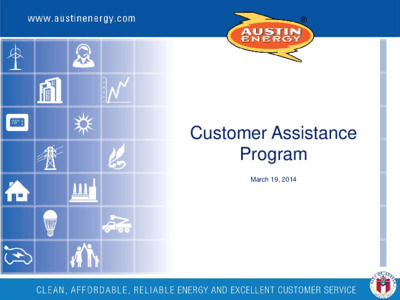March Power Point Presentation — original pdf
Backup

Customer Assistance Program March 19, 2014 Customer Assistance Programs Who are we? The Customer Assistance Program (CAP) encompasses all of the City of Austin sponsored programs designed to assist moderate to low-income customers in regards to their utility bill. What do we do? The goal of the Customer Assistance Program is to maximize the participation of eligible City of Austin utility customers by better promoting and presenting these programs to utility customers, civic, public, and private organizations. Why? Austin Energy promotes programs designed to provide assistance to customers in the areas of financial support, case management, dispute resolution, energy efficiency improvements and water conservation. 2 Program Components • Discounts • Financial Support Plus 1 • Medically Vulnerable Registry • Education Classes • Weatherization • Community Connections Resource Fair • Case Management Project • Affordable Energy Policy Summit • Pilot Projects 3 Discount Program-The Beginning •Established 1985 •COA Utilities’ first program to assist low income customers •Original Partner Utilities: •Austin Energy •Public Works •Watershed Protection •Austin Water joined in 2009 4 Discount Program-Description Provides significant monthly discounts to City of Austin utility customers for a continuous 12 month period. The average customer is provided about $64 in monthly discounts 5 Discount Program – The Present 6 •Case Management & Evaluation Case Management & Evaluation Case Management & Evaluation Weatherization Discounts Education Discount Program-Description Discounts available •Electric Service Customer Charge waiver •Discount (10%) on total electrical usage •Discount on Community Benefit Charge (CAP) •Water Service Customer Charge waiver •Water Tiered Fixed Charge Waiver •Water Volume Charge discount •Wastewater Service Customer Charge waiver •Drainage Fee 50% discount 7 Discount Program-The Present Discount Program •50% growth – enrollment •75% growth – funding •New qualifiers •All Medicaid types •Supplemental Nutrition Assistance Program (SNAP) •Children’s Health Insurance Program (CHIP) •Telephone Lifeline Program •Travis County Comprehensive Energy Assistance Program (CEAP) •Medical Access Program (MAP) •Automatic enrollment 8 Discount Program-The Present Education component •Required pre-requisite for all weatherization program participants •One interactive 4 hour class for the whole family •Flexible class schedules •Spanish classes available Weatherization component •Targets high usage customers •(4mth ≥2,500 kWh or 6mth ≥1,500 kWh) •Home energy audit •Appliance replacement 9 Discount Program-The Present Utility Discount Program (electric only) Customers Served 43,029 Average Household Savings Per Month $23.00 Customer Savings $11,921,603 10 *Numbers from FY06-12 Plus 1-Description The Financial Support Plus 1 program helps customers who are having financial difficulties and are unable to pay their utility bill due to unexpected emergencies. 11 Plus 1-The Beginning Financial Support Plus 1 Program •Established 1991 •3 partners •Limited funds •Established donation program 12 Plus 1-The Present Financial Support Plus 1 Program •Internal yearly customer segmentation •External customer segmentation from 2-1-1 •Data provides two perspectives –Internally what is happening with customer base –Externally what are our customers struggling with on a daily basis •Identifies service gaps within service territory •Identifies outreach target areas •24 Partners / 30 Service Sites •Expanded Funding ($1,000,000) •Agency Budget Plan 13 Plus 1-The Present Financial Support Plus 1 Program Expensed $2,041,957 Households Served 10,761 14 *Numbers from FY06-12 Medically Vulnerable Registry-Description The City of Austin offers the Medically Vulnerable Registry for customers with life support equipment, a serious illness or chronic illness. Eligible customers receive additional time to pay their bills in addition to one-on-one case management. 15 Medically Vulnerable Registry-The Beginning Medically Vulnerable Registry Program •One category (Life Support) •Special payment arrangements 16 Medically Vulnerable Registry-The Present Medically Vulnerable Program •Expanded protections •Life Support equipment (228 HH) •Critical Illness (43 HH) •Serious Illness (16 HH) •Home visits •New enrollments •Yearly contact •Referrals to other social service providers •One-on-one case management •Manual collections process •Third party notification 17 Other Program Components Case Management Project •Community based organizations serving high risk populations •Families with children who have severe medical issues •Elderly low income •Families struggling with HIV/AIDS •Homeless veterans •Single point of contact from Austin Energy •Customer Solution Coordinators (CSC) •Direct contact with agencies •Create comprehensive action plans •Flexibility in policy decisions 18 Other Program Components Community Connections Resource Fair •Utility meets customer at community level •Holistic approach to customer service •One-stop place to reach basic needs services •Targets low to moderate income customers •Focuses on high poverty zip codes •Over 800 participants with over 90 community agencies represented 19 Other Program Components Refugee Project •Two agency collaboration •Refugee Services of Texas •Caritas •Customers denied services because of inability to provide a valid ID •Worked within the confines of our service regulations •Potential customers were vetted by federal government •Utilized I-9 ID’s as a temporary ID •6 weeks later social security number is provided •Account case managed by Austin Energy •Accounts in customer’s own name •Accounts are managed until social security numbers are provided •Customer case managed by Referring Agency •Education about utility bill •Understanding a utility bill •How to manage their utility bill •Paying their utility bill 20 Other Program Components Affordable Energy Policy Summit •Introduces utility changes to the community •Communication avenue for community partners •Community Input •Targets local social service providers •Non-profits •Faith-based groups •Government agencies •Advocacy groups •Low income housing representatives 21 Results Number of Participants 23 Successful 17 Removed 6 Median PA Length 4 months Longest 6 months Shortest 3 months Median AE Pledge $296 Largest $500 Smallest $85 Median Balance $972 Largest $3,200 Smallest $327 Fixed Income Project (FIP) •Elderly customers •Past due utility debt •Single agency collaboration Pilot Projects 22 Results Number of Participants 7 Successful 3 Removed 4 PA length 6 months Median AE Pledge $270 Median Balance $849 Homeless Utility Project •Customers transitioning from homelessness •Old past due utility debt •Children of homelessness Pilot Projects 23 Success •Ongoing community dialogue •Internal cross-functional programming •Coalition building •Utility Financial Integrity •Interpersonal dynamics with customer base •Utility awareness of community conditions •Understanding individual customer needs •Customer segmentation •Community perception of the utility •True partner for a multi-faceted community 24 Questions? 25